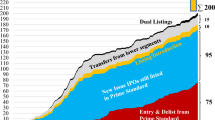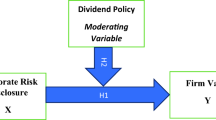Abstract
The present paper investigates whether small firm entrepreneurs are able to signal the value of their firms to potential investors when seeking a listing on the U.K. Unlisted Securities Market (USM). The signals considered are the percentage of equity retained by the original entrepreneurs, the net proceeds raised by an issue, the choice of advising agents to an issue, the disclosure of an earnings forecast and the level of underpricing of the new issue. In addition, the possible interactions between the individual signals are considered and included in the analysis. The results of the empirical analysis suggest that firm value is positively and significantly related to the percentage of retained equity and the net proceeds raised: thus suggesting, therefore, that stock markets will invest at higher values, ceteris paribus, if entrepreneurs indicate confidence in their enterprises via levels of equity retention and the funds they intend to invest in future projects.
Similar content being viewed by others
Bibliography
Akerlof, G., 1970, ‘The Market for Lemons: Qualitative Uncertainty and the Market Mechanism’, Quarterly Journal of Economics 84, 488–500.
Allen, F. and G. R. Faulhaber, 1989, ‘Signalling by Underpricing in the IPO Market’, Journal of Financial Economics 23, 303–323.
Baron, D. P., 1982, ‘A Model of the Demand for Investment Banking Advising and Distribution Services for New Issues’, Journal of Finance 37, 955–976.
Beatty, R. P., 1989, ‘Auditor Reputation and the Pricing of Initial Public Offerings’, Accounting Review 64, 693–709.
Beatty, R. P. and J. R. Ritter, 1986, ‘Investment Banking, Reputation and the Underpricing of Initial Public Offerings’, Journal of Financial Economics 15, 213–232.
Bhattacharya, S., 1979, ‘Imperfect Information, Dividend Policy and the “Bird in the Hand” Fallacy’, Bell Journal of Economics 10, 259–270.
Bhattacharya, S., 1980, ‘Nondissipative Signalling Structures and Dividend Policy’, Quarterly Journal of Economics 95, 1–24.
Bhattacharya, S. and J. Ritter, 1983, ‘Innovation and Communication: Signalling with Partial Disclosure’, Review of Economic Studies 50, 331–346.
Buckland, R. and E. W. Davis, 1987, ‘Barriers to Entry in the Unlisted Securities Market: The Significance of Administrative Expenses’, Accounting and Business Research 17(68), 301–309.
Buckland, R. and E. W. Davis, 1989, The Unlisted Securities Market, Oxford; Clarendon Press.
Buckland, R., P. J. Herbert, and K. A. Yeomans, 1981, ‘Price Discount on New Equity Issues in the UK and Their Relationship to Investor Subsciption in the Period 1965–75’, Journal of Business Finance and Accounting 8(1), 79–95.
Downes, D. H. and R. Heinkel, 1982, ‘Signalling and the Pricing of New Issues’, Journal of Finance 37, 1–10.
Grinblatt, M. and C. Y. Hwang, 1989, ‘Signalling and the Pricing of New Issues’, Journal of Finance 44, 393–420.
Heinkel, R. and E. S. Schwartz, 1986, ‘Rights versus Underwritten Offerings: An Asymmetric Information Approach’, Journal of Finance 41, 1–18.
Hughes, P. J., 1986, ‘Signalling by Direct Disclosure under Asymmetric Information’, Journal of Accounting and Economics 8, 119–142.
Jarque, C. M. and A. K. Bera, 1980, ‘Efficient Tests for Normality, Homoscedasiticity and Serial Independence of Regression Residuals’, Economic Letters 6, 225–229.
Krinsky, I. and W. Rotenberg, 1989, ‘Signalling and the Valuation of Unseasoned New Issues Revisited’, Journal of Financial and Quantitative Analysis 24, 257–266.
Leland, H. E. and D. H. Pyle, 1977, ‘Informational Asymmetries, Financial Structure and Financial Intermediation’, Journal of Finance 32, 371–387.
Ritter, J. R., 1984, ‘Signalling and the Valuation of Unseasoned New Issues: A Comment’, Journal of Finance, 39, 1231–1237.
Rock, K., 1982, ‘Why Are New Issues Underpriced’, Unpublished Ph.D. Thesis, University of Chicago, Chicago.
Rock, K., 1986, ‘Why Are New Issues Underpriced’, Journal of Financial Economics 15, 187–212.
Ross, S., 1977, ‘The Determination of Financial Structure: The Incentive Signalling Approach’, Bell Journal of Economics 8, 23–40.
Tinic, S. M., 1988, ‘Anatomy of Initial Public Offerings of Common Stock’, Journal of Finance 43, 789–822.
Titman, S. and B. Trueman, 1986, ‘Information Quality and the Valuation of New Issues’, Journal of Accounting and Economics 8, 159–172.
Trueman, B., 1986a, ‘The Relationship Between the Level of Capital Expenditures and Firm Value’, Journal of Financial and Quantitative Analysis 21(2), 115–129.
Trueman, B., 1986b, ‘Why Do Managers Voluntarily Release Earnings Forecasts?’ Journal of Accounting and Economics 8, 53–71.
Verrecchia, R. E.,1983, ‘Discretionary Disclosure’, Journal of Accounting and Economics 5, 179–194.
Welch, I., 1989, ‘Seasoned Offerings, Imitation Costs, and Underprincing of Initial Public Offerings’, Journal of Finance 44, 421–449.
White, H., 1980, ‘A Heteroskedasticity-Consistent Covariance Matrix Estimator and a Direct Test for Heteroskedasticity’, Econometrica 48, 817–838.
Author information
Authors and Affiliations
Rights and permissions
About this article
Cite this article
Keasey, K., Short, H. & McGuinness, P. New issues on the U.K. Unlisted Securities Market: The ability of entrepreneurs to signal firm value. Small Bus Econ 4, 15–27 (1992). https://doi.org/10.1007/BF00402212
Accepted:
Issue Date:
DOI: https://doi.org/10.1007/BF00402212




